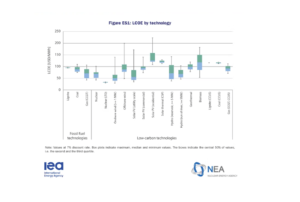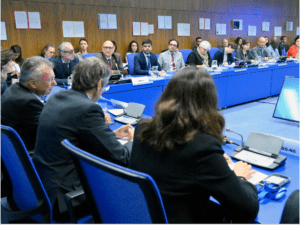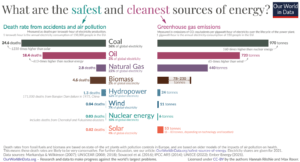18 year-old Erin Walshaw investigates our most controversial power supply

Currently, 10% of global energy is generated through nuclear methods, according to the World Economic Forum.
May 16, 2024
Energy in crisis: why nuclear power could be our future
Since the Industrial Revolution, one primary question has been central to all of humanity’s technological advancements: how do we generate enough energy?
Historically, energy was generated with the easiest, cheapest, and most accessible fuel source: coal. However, the dangers of fossil fuels mean that we must find an alternative to ensure Earth continues to be habitable.
Thankfully, alternatives exist, with one much more daunting than the others – nuclear.
With coal power plants accounting for a fifth of global greenhouse gas emissions, a transition to nuclear power is one of the only currently viable solutions to halt the speed at which we pollute the environment.
Replacing the world’s coal plants with nuclear power would reduce carbon dioxide emissions to levels last seen in the 1970s, buying us essential time to determine how to save the environment from destruction.
About half of the world’s carbon dioxide emissions come from the Asia Pacific region, and the West needs to do everything in its power to help countries in this region move from coal to nuclear energy. We must also acknowledge our own role in the consumerism that fuels the climate crisis.
First world countries including the US and Canada must also be aware that our per capita emissions are approximately 150 times higher than that of poorer countries such as Chad and Niger.
According to the World Economic Forum, 10% of global energy is generated through nuclear methods However, in order to reach net zero, this is not enough. At the COP28 climate conference in December of 2023, more than twenty countries launched the Declaration to Triple Nuclear Energy, which will kickstart international goals to triple nuclear energy capacity by 2050.
Now, let’s discuss pressing questions around a transition of this scale.
What is the cost of transitioning to nuclear energy?
While estimating the exact cost of transitioning to nuclear energy is impossible, numbers for previous nuclear projects give us a reasonable picture of the expected amount. The metric to determine the cost of a generating plant is the levelized cost of electricity (LCOE), which represents the total cost of building and operating a plant divided by its lifetime energy output in units of dollars per megawatt hour (MWh).
According to the World Nuclear Association, there are three primary costs to operating a power plant: capital costs, which include site preparation, materials, and labour; plant operating costs, which include fuel, operational and maintenance costs, and a fund for decommissioning the plant and safely disposing of waste; and external costs to society, which are generally assumed to be zero for nuclear plants. Additional costs include system costs and taxes.
A report by the Nuclear Energy Agency and the International Energy Agency found the LCOE of nuclear energy is expected to be $55-95 per MWh in 2025, whereas coal is expected to be $100 per MWh. Furthermore, the report estimates that nuclear plants in long-term operation will have a LCOE of less than $40 per MWh, making it considerably cheaper than both fossil fuels and other low-carbon options.
Modern industrial activity has raised carbon dioxide levels in our atmosphere by almost 50% since 1750. Unfortunately, increased emissions of greenhouse gases as a result of human activity are causing the planet to artificially heat up.
While the greenhouse effect is necessary to sustain life on earth, higher global temperatures exacerbate the severity of natural disasters, pollute the air, increase the rate of wildlife extinction, and raise sea levels. Despite current efforts to reduce the impact of climate change, it is clear that widespread change is needed to take the load off the environment.
Nuclear energy is a reliable form of low-carbon energy that has reduced CO₂ emissions by over 60 gigatonnes in the last 50 years by functioning as an alternative to fossil fuels. It has a low carbon footprint, requires less land, and is cheaper for consumers than many other forms of energy.
Can technology improve nuclear energy?
Current technological advancements that are improving the safety of nuclear energy generation include new coolants, alternative fuel sources, artificial intelligence (AI) modelling, and small modular reactor designs.
While most nuclear plants use water as a coolant, other options can reduce the pressure of the coolant and be kept at high temperatures to increase efficiency. Multiple companies are looking into using molten salt to cool their reactors, which has the bonus of creating designs that use less fuel and create easier-to-manage waste.
Tri-structural isotropic particle fuel (TRISO) is regarded as ‘the most robust nuclear fuel on earth’ by the Office of Nuclear Energy, which describes TRISO particles as being ‘made up of a uranium, carbon and oxygen fuel kernel. The kernel is encapsulated by three layers of carbon- and ceramic-based materials that prevent the release of radioactive fission products’.
Because of AI's ability to model complex situations and problem-solve, it can be used to create digital models and simulations of nuclear reactors to optimise efficiency and improve safety.
Another technology revolutionising the current nuclear energy scene is the small modular reactor (SMR). Newer models of SMRs include new emergency cooling and heat removal systems that make them safer for those operating them. Because they are easier to install, SMRs are an appealing option during our transition to nuclear energy.
Is nuclear energy ‘green’ or renewable?
The simple answer to this question is that nuclear energy is ‘greener’ than fossil fuels, but has its own challenges regarding renewability. Unfortunately, energy is more complicated than simply being ‘green’ or ‘bad’ for the environment, and solving these problems will be crucial in humanity’s journey towards a climate-friendly future.
The best way to examine how environmentally friendly an energy source is to look at its carbon footprint and waste products. Small amounts of fuel can generate large quantities of energy, but this also means that nuclear waste is undeniably dangerous because it is radioactive and at a high temperature. The average amount of nuclear waste per person per year is the size of a brick, and only 5g of this would be considered ‘high-level’ waste.
Furthermore, nuclear energy has near-zero carbon emissions, and, according to the Breakthrough Institute, ‘when compared to coal, natural gas, and renewables, nuclear is the most land efficient, energy-dense source of power, with the lowest use of building materials per unit of energy generated per year, and one of the least expensive in terms of levelized costs’.
Can existing infrastructure be used?
A groundbreaking 2022 report prepared for the US Department of Energy Systems Analysis and Integration explored the potential of widespread coal-to-nuclear transition across the US and proposed the idea of repurposing existing infrastructure to create cheaper, more efficient, and greener energy. The team evaluated recently retired plants and those operating coal-fired power sites to determine their availability for transition.
The report estimates that 80% of coal plant sites (both retired and operating) possess the required basic characteristics for conversion from coal to nuclear. Additionally, with many coal plant owners under pressure to retire their plants, the coal-to-nuclear transition is a way to recoup some of the costs while maintaining jobs and economic benefits.
“With coal plants retiring, a transition to nuclear means we can continue to use the expertise of coal workers and infrastructure developed over decades to achieve our climate goals while delivering well-paid, highly skilled jobs in coal communities,” said Maria Korsnick, president and CEO of the Nuclear Energy Institute.
Building an SMR nuclear plant is currently estimated to bring 1,600 jobs for a three-year period during the reactor’s construction, which would help revitalise local economies and communities, and increase the job market for engineering and construction graduates.
What is nuclear waste and how is it disposed of?
Nuclear waste is classified into three categories: low-level, which accounts for about 90% of waste; intermediate-level, which accounts for around 7% of waste, and high-level, which accounts for roughly 3% of waste and 95% of overall reactivity of nuclear waste.
The high density of nuclear fuel means that small amounts of fuel can be used to supply large quantities of electricity. Because of the efficiency of nuclear energy, progress is being made to determine a safe and reliable storage method long-term. Currently, nuclear fuel is cooled off in water for up to five years, then stored in reinforced concrete containers. Often, fuel can also be reused to generate more electricity.
A 1,000-MW power station, which can serve upwards of a million people, produces only 3m3 of high-level waste per year, assuming used fuel is recycled efficiently. A comparative coal plant would produce 300,000 tonnes of ash and 6mn tonnes of carbon dioxide.
What are the dangers of nuclear energy?
Nuclear energy, like other energy sources, isn’t perfect, and there are some inherent risks that come with this form of electricity generation. A major concern is the long-term storage of nuclear waste, which poses significant environmental risk because it can be dangerous for thousands of years. However, with proper disposal and storage systems in place, the concrete and steel containers the fuel is stored in after an initial cooling period are safe enough to walk up to and touch.
Tragedies such as the Chernobyl (Ukraine, 1986) and Fukushima (Japan, 2011) disasters have led to widespread concern about the safety of nuclear plants. The Chernobyl accident occurred after technicians attempted an experiment that involved shutting down emergency safety systems. The resulting explosions caused a partial meltdown of the core and released vast amounts of radioactive material into the air. Dozens contracted radiation sickness, millions of acres of land were contaminated, and generations of livestock were born deformed. It was predicted that thousands of deaths due to radiation-related illnesses would occur.
However, when proper safety practices are in place and reactors are operated correctly, nuclear energy is a very safe alternative to other methods. Companies involved with nuclear energy are acutely aware of the risks involved.
The World Nuclear Association states: “The evidence over six decades shows that nuclear power is a safe means of generating electricity. The risk of accidents in nuclear power plants is low and declining.” Regulatory bodies worldwide have assessed the safety risks highlighted by these accidents, and comprehensive stress tests have been performed.
To conclude, nuclear energy is relatively safe, estimated to kill around 350 times fewer people than coal power per terawatt-hour of energy produced. As long as regulatory bodies such as the United States Nuclear Regulatory Commission and the Canadian Nuclear Safety Commission continue to ensure the safe and ethical use of nuclear energy, it will remain a viable option to guide us towards a greener and safer future.
There is no denying that nuclear energy is an inevitable step in humanity’s path, most notably because it moves us one step closer to our climate goals, saves money, improves reliability of the energy grid and creates jobs and improves local economies.
What is perhaps most essential to ensuring the success of this transition is federal, provincial, state, and local policies across countries to ensure we are collectively working towards the United Nations’ sustainable development goal 7 – affordable and clean energy.







